Background of the Organization
Brief history of the company
Nokia Corporation is one of the most prosperous electronic firms in the world. This firm was started in 1865 by two Finnish scientists, Fredrik Idestam, and Leo Mechelin. These two individuals were business enthusiasts.
They were interested in turning their skills in engineering into a large business unit. Fredrik Idestam was an astute engineer with a keen interest in ground pulp mill.
This was the first line of business that this firm engaged in. Fredrik Idestam was a smart engineer who managed to develop systems that could make the company run with a lot of ease.
On the other hand, Leo Mechelin was a statesman who was able to finance the company and bring on board individuals with the capacity of transforming the firm. Change within this organization was witnessed in those early years of its development.
As the company developed, Idestam became the chairman of this company.
Based on his experience and the connections he had both with the government and other non governmental institutions, Mechelin was convinced that the firm would make more profits if it ventured into the electricity industry.
However, this move was strongly opposed by Idestam who was the chairman then. He did not understand the need to change the product line of the firm or diversify, while the current product was considerably profitable.
Upon his retirement in 1896, Mechelin became the chairman of the firm. He was able to convince other members to consider diversification of the products by entering into the electricity industry.
That was the first attempt that this firm made towards change. The expansion of this firm in those early years was basically due to conglomeration. In 1967, Nokia Corporation had expanded and had the capacity to sell its products outside the home country of Finland.
The firm entered the electronic industry in the mid 1960s as a division of the electric department.
This division expanded very first, and would later become the main department of this firm in the world market.
Nokia developed its first cellular phone in 1981, which gained a lot of popularity in 1980s. This developed this industry, and currently, it is considered one of the leading electronic firms in the global market.
Organizational context for change
The world is changing, and with it comes a number of changes in the organizational setting. According to Adams (75), change is one of the factors that cannot be avoided within the organization.
It defines an organization and the society at large. As Anderson (73) puts it, change is the most constant factor in human’s life, and to any organization.
One of the main changes that this firm has undertaken in the recent past was the signing in of Stephen Elop as the chief executive of the firm. He created a strategic alliance between Nokia and Microsoft.
This agreement has enabled Nokia diversify its products in the market. The firm has been able to make a shift from Symbian to Windows OS in their phones. Under his leadership, Nokia has also shifted its focus from regular phones to Smartphone is more popular in the current market.
This is a clear indication that the entire firm, from the top management, to the junior most employees appreciates the need for change within an organization. It is therefore, intriguing that most stakeholders would try to oppose change.
People would feel uncomfortable changing the set structures. A manager who is used to a certain way of doing things will feel challenged when forced to use a different strategy due to the pressures of change.
Technology itself is a change, and many firms have failed due to their inability to adapt to the changes brought about by technology. Kodak was displaced by Fuji Film as the market leader due to its inability to implement changes that were brought forth by technology.
It is therefore, an obvious fact that change cannot be ignored. It should be embraced in order to gain a competitive advantage in the firm.
The driving forces of change and type of strategic renewal
Change is driven by a number of factors, and as Adams (94) notes, the drivers of change can broadly be categorized as external or internal factors.
A transformation can be driven by the macro or micro factors within an environment. In order to have a clear understanding of the external drivers of change, PESTEL analysis would be appropriate.
Political environment is an external driver of change. As Bradford (98) observes, if there is a radical change in the political structure of a country, the effect will definitely be felt within the organization.
Economical status of the external environment will also act as an agent of change. For instance, the economic recession of 2008/2009 was a serious change driver.
Because of the recession, firms were forced to come up with a changed management structure to suite the prevailing market conditions within the environment.
The social structure of a society will always act as an agent of change. The societal changes can be caused by the changing trends in the society. This will act as a driver of change within the society for it will be forced to adjust in order to be in line with the prevailing societal conditions.
Technology is probably the biggest driver of change. The world is changing due to the changes brought about by technology. Scientists are under constant pressure to make life easier and more entertaining, and as Anderson (88) notes, they have not disappointed.
The internal drivers of change within an organization are the stakeholders whose actions will have a direct impact on the organization.
The internal drivers of change may also be considered as the agents of change. The agents of change are the forces that would carry out the change. The recent changes that have taken place within Nokia Corporation clear demonstration of what internal forces can do in order to bring change within an organization.
Risto Siilasmaa has been both an agent for a negative and positive change within this firm. When appointed as the chairman of this organization, there was an unprecedented fall in the profitability because he failed to offer approach of leadership that was expected by various stakeholders. This was until he came to understand this industry and the firm in particular.
Risto Siilasmaa became an agent of positive change within this firm. He came up and challenged all the existing structures within the organizations, and fostered new approaches regardless of the opposition that was given by various stakeholders within the firm. This resulted in an upward trend in the profitability of the organization.
The agents of change will include the top management of an organization, as was in the case of Nokia Corporation, the middle level or junior employees, or the shareholders of the firm.
These agents will work as a unit to ensure that they achieve the ultimate goals of the organization despite the changing environmental factors.
The stakeholders involved and implications of change for them
As mentioned above, there are a number of stakeholders who are always involved in change within the organization. These stakeholders can be categorized as internal stakeholders and external stakeholders.
The employees, shareholders the and management form the internal stakeholders of the firm. Employees are the wheels upon which change can be implemented within the firm.
The implication of change on them is that they will be forced to adapt to the new strategies brought about by the change.
The management is the engine through which change can be realized within an organization.
The shareholders offer the necessary finance that will fuel the firm to manage changes that take place in the market.
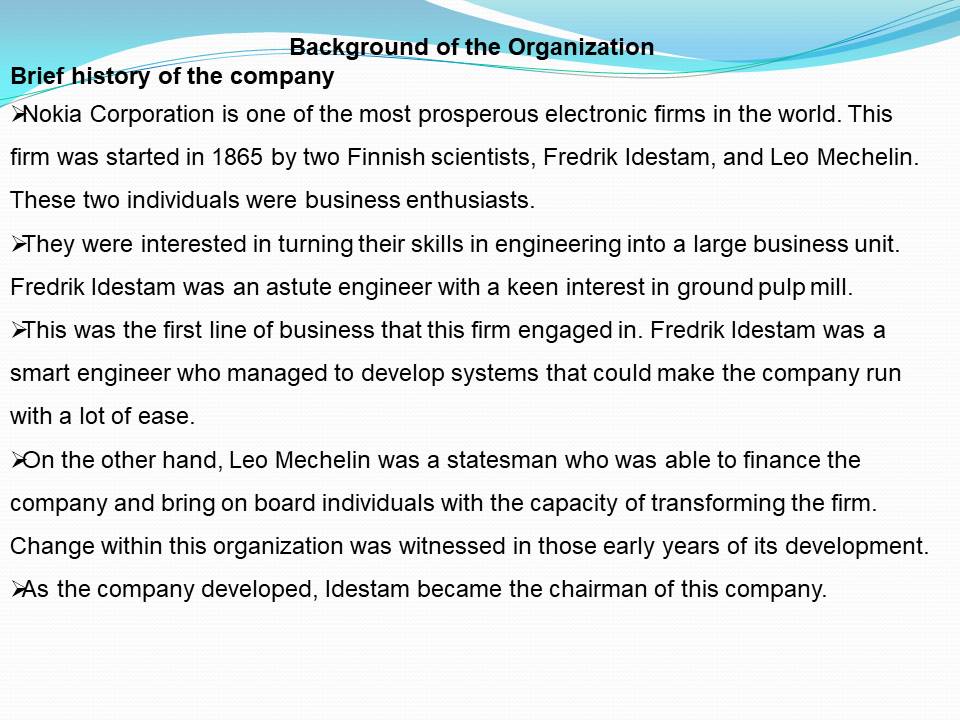
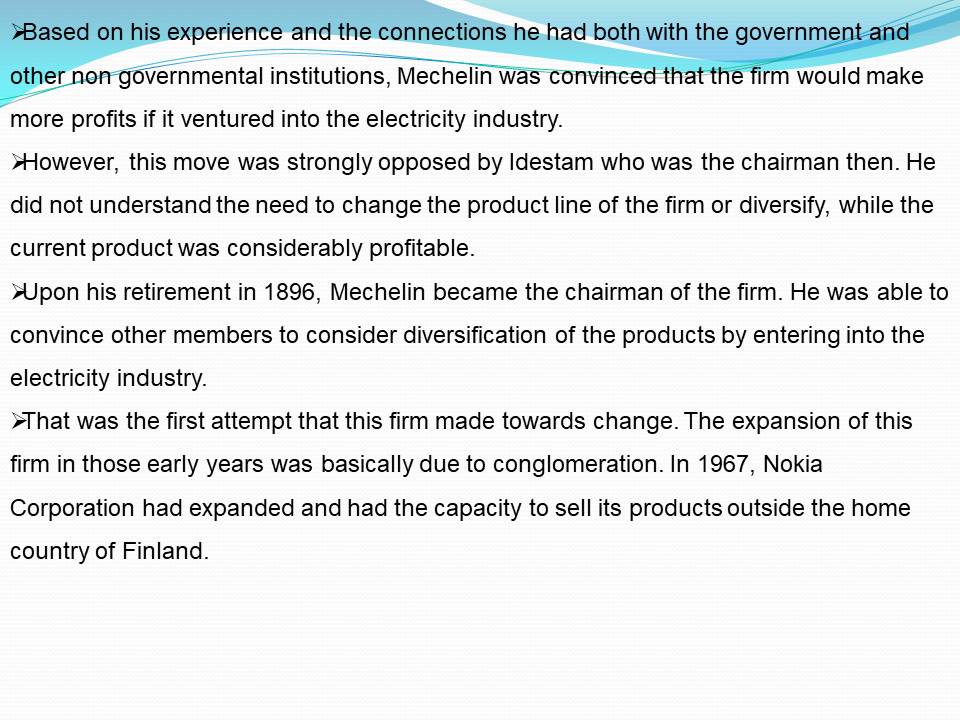
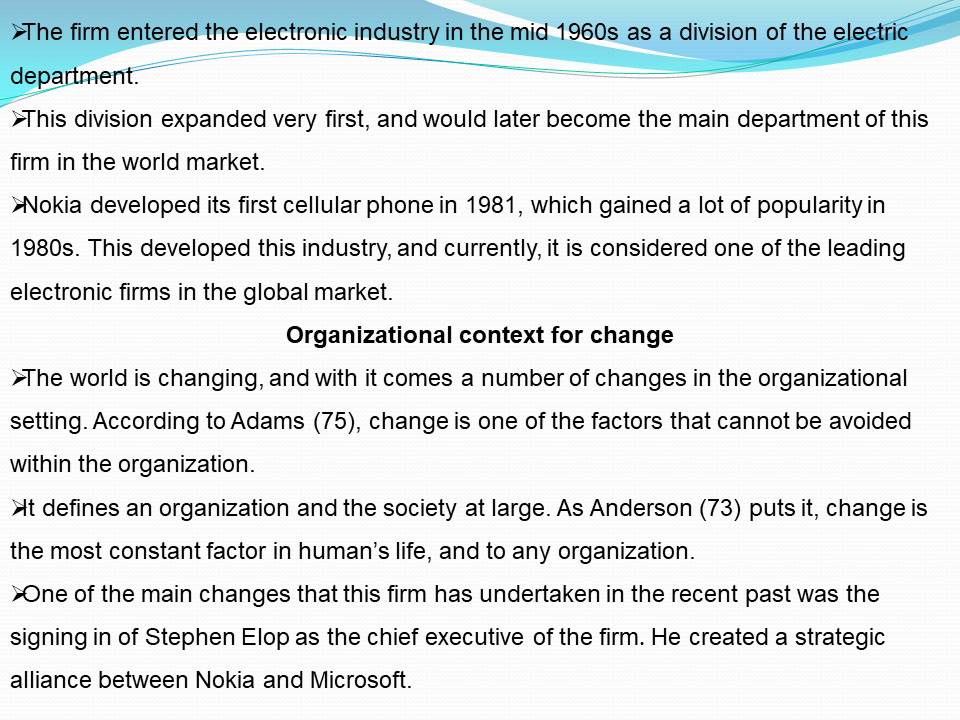
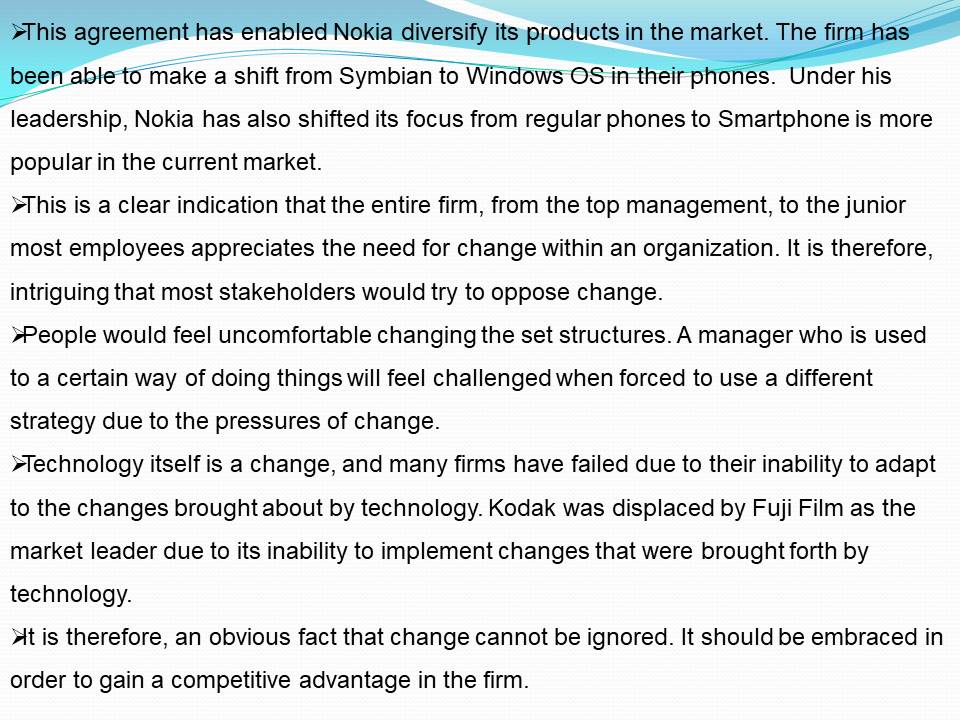
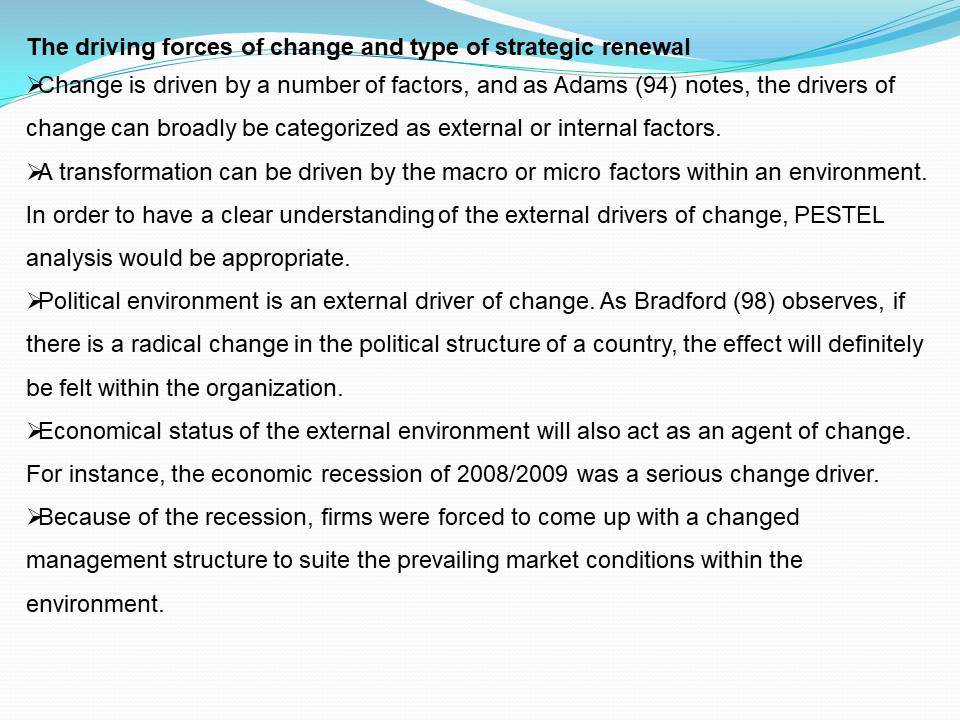
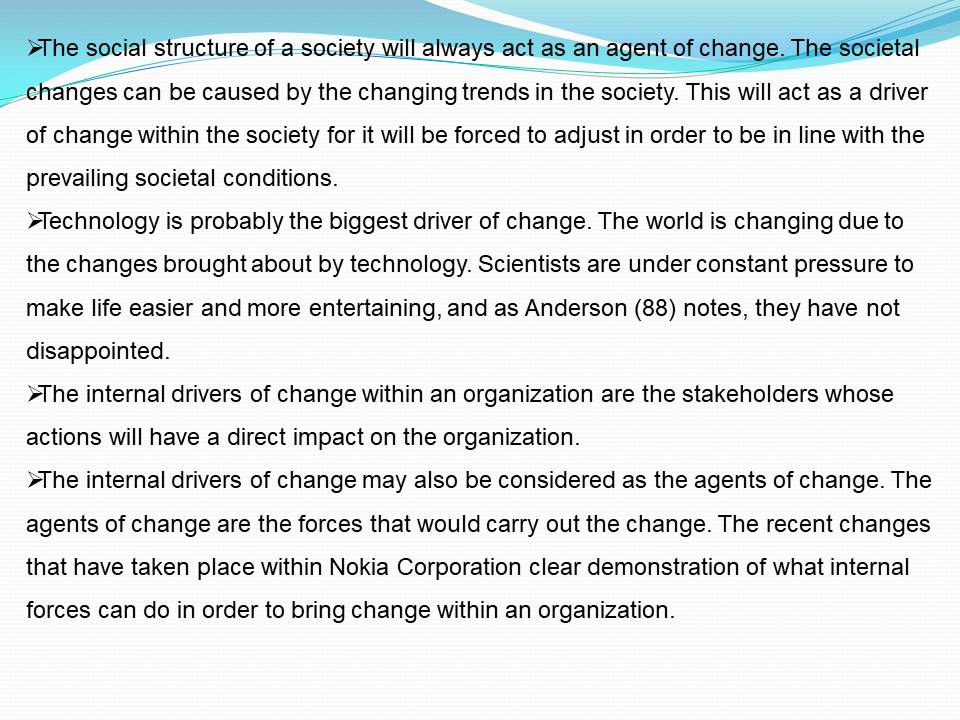
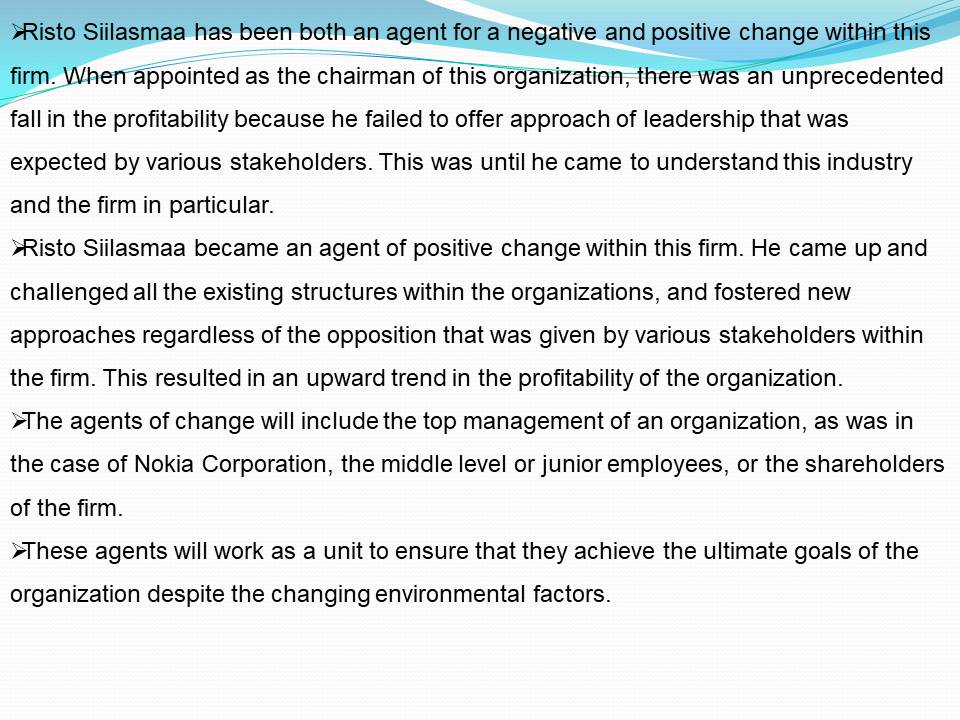
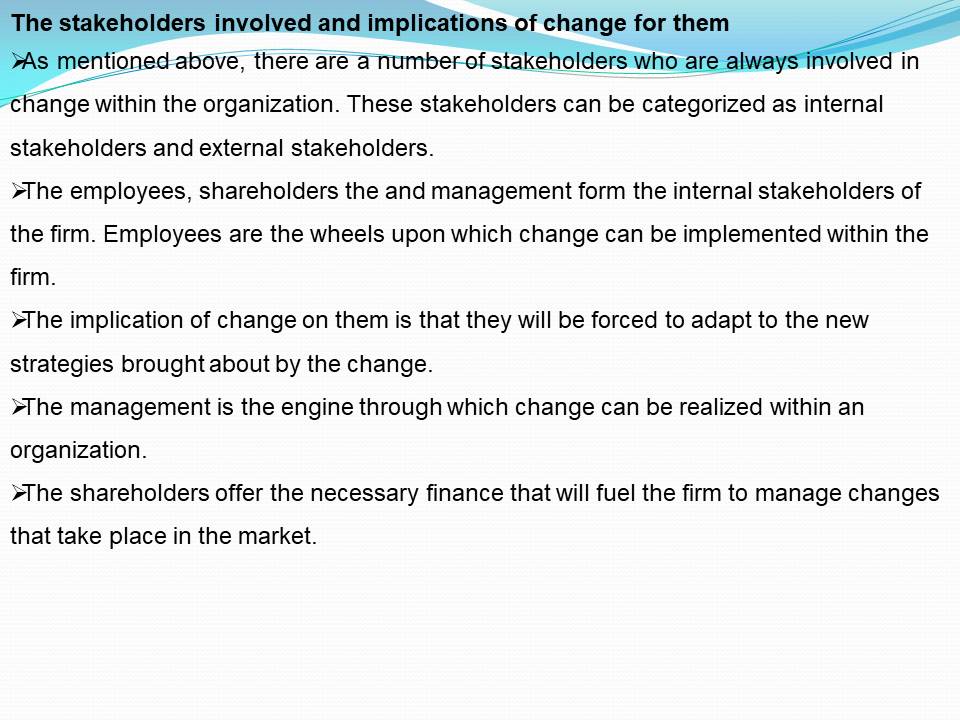
Culture of Nokia Corporation
The original culture
Culture is very important within an organization. According to Cummings (117), organizational culture helps defines the approach through which an organization will always approach a number of issues in the market.
Nokia has had a culture which has defined the approach of managing various issues in the market. The original organizational culture of Nokia was a little rigid towards change. This culture defined the relationship between the management and the employees.
There was a strict hierarchical flow among the employees. It was not possible for an employee of a lower rank to bypass the immediate boss to a more senior officer. That was regarded as insubordination and an employee could be punished for that.
Cultural changes over the years
This rigid management structure has changed over the years. The management of Nokia has become very flexible and sensitive to changes taking place in the environment.
The firm has changed its organizational culture to reflect on the current dynamic world. It has dropped the bureaucratic leadership style that was commonly used before.
Employees can express their thoughts to senior management without fear of punishment. The culture has also embraced dynamism brought about by the emerging technology. The firm is very keen on adapting to the new technological changes in the market.
How the culture helped or hindered the change effort
As was witnessed, rigid organizational culture has negative impact on change. It inhibits the possible changes that may help the firm in the market. This was a hindrance to Nokia.
However, when Nokia changed this culture to a more flexible one, it became easier to manage change with minimal effort. As Bradford (114) notes, the ability of a firm to manage change directly depends on the organizational culture it embraces.
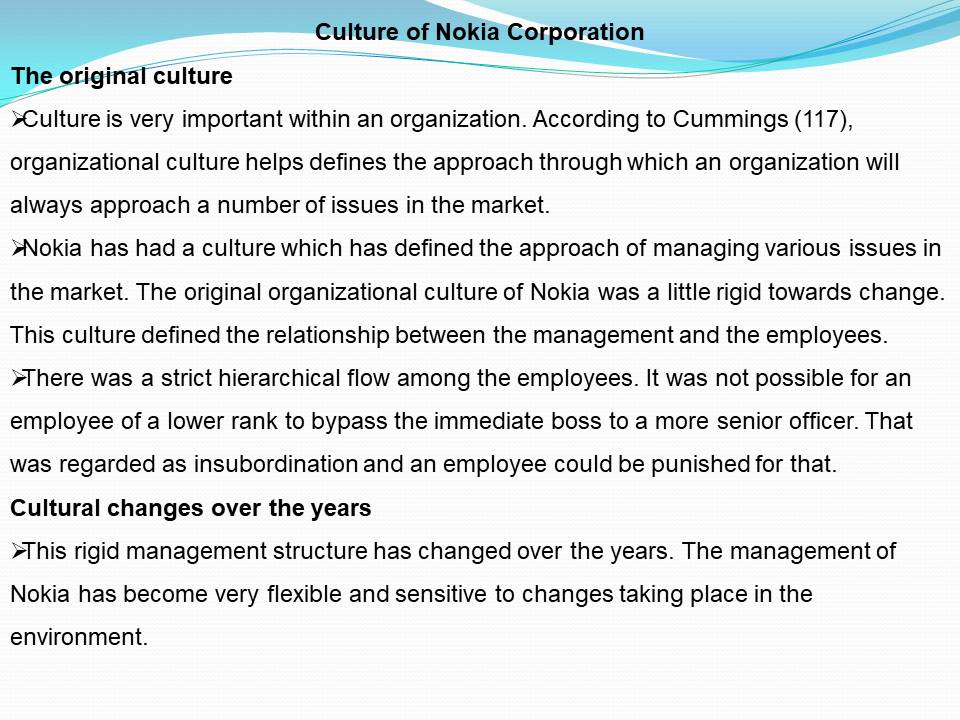
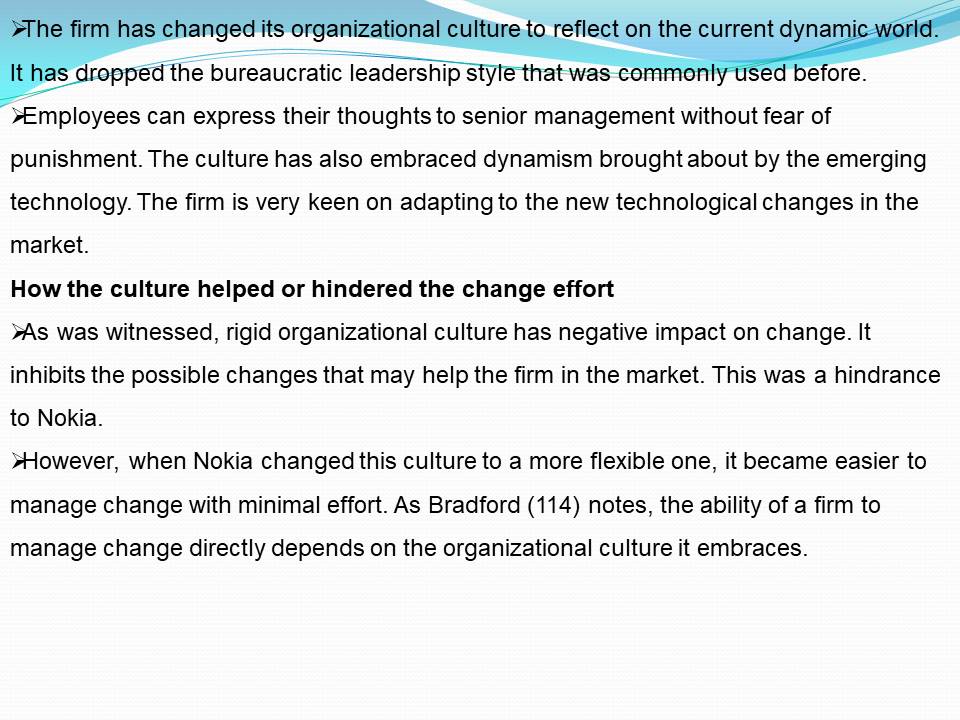
The adaptive nature of the change
Firms should find a way of adapting to change. Nokia was able to adapt to the emerging market trends when it changed its organizational culture, a move that saw it become one of the largest electronic firms in the world.
The external market forces are never static, and for a firm to be successful, it is vital that it develops strategies that are sensitive to change in order to help it manage market forces.
The Change Effort Itself
Evaluating the change effort using a model
Lewin’s three staged change management model is one of the simplest and most common change models that are in use in the current business environment. The model is also popularly known as unfreeze, change and freeze model.
This strategy proposes a scenario where if a firm plans for a change, it should accept that change is necessary.
It should drop some of the long term strategies that may hinder change. The firm should then introduce change within the system.
After this, it should make all the relevant stakeholders understand this change in a process called freezing.
This process has both positive and negative impacts. Change brings positive impacts to a firm because it allows it create an environment where it can easily adapt to the emerging technologies.
However, it may be an expensive venture, especially if it massively affects the firm. It will force the management to overhaul part of it and even subject their employees to intensive training.
In assessing effectiveness of change, it is always necessary to look at the way employees have altered their output over a certain period. Embracing change involves incurring some costs.
These costs must translate into profitability for the firm. For this reason, the effectiveness of change can directly be determined by looking at the productivity and profitability of the firm before and after initiating change.
Leadership of the Change Effort
Change can only be realized if there is a proper leadership structure within the firm.
A change effort would always demand for a proper management for there to be a clear direction towards successful change management.
According to Cummings (90), change will always start from the management. This fact was confirmed when the first chairman of Nokia, Fredrik Idestam, resisted change.
It is only upon his retirement that Nokia was able to bring a number of changes in management structure, and product offerings. As such, the leadership should always be looked at as the engine that drives change within a firm.
It is therefore, important for leaders to display core characteristics of leadership change when managing the employees. The extent to which this should be done will always depend on the nature of change that is needed.
In case change needed may have a serious impact to the firm, it is necessary for the management to get deeply involved in the change, from the top management to junior management.
However, there are some changes that are considered minor, and therefore, should be left in the hands of junior managers of the firm.
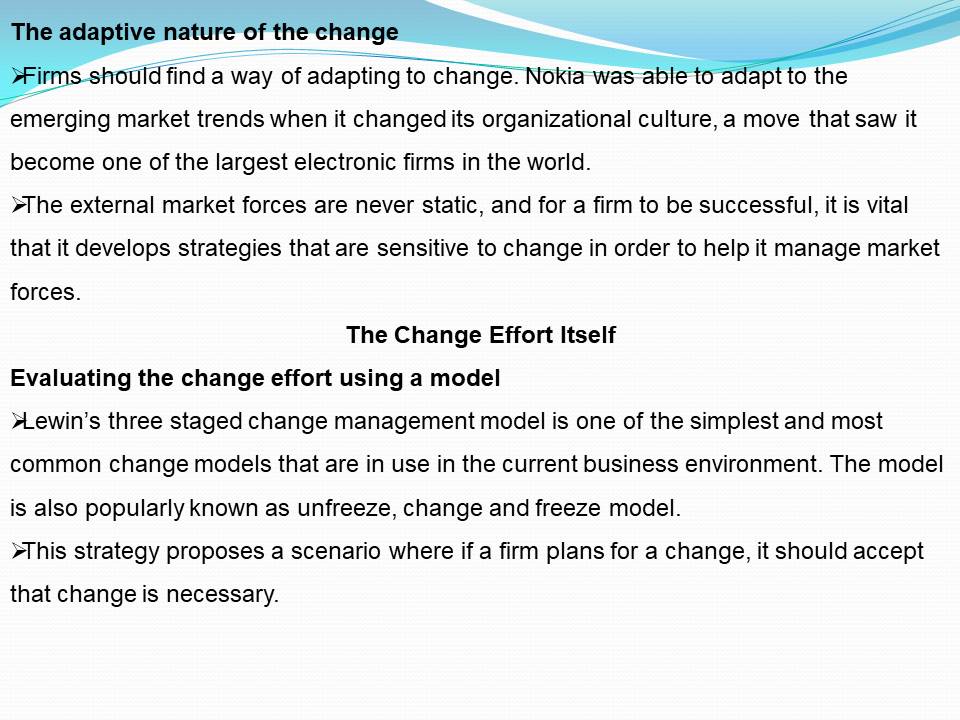
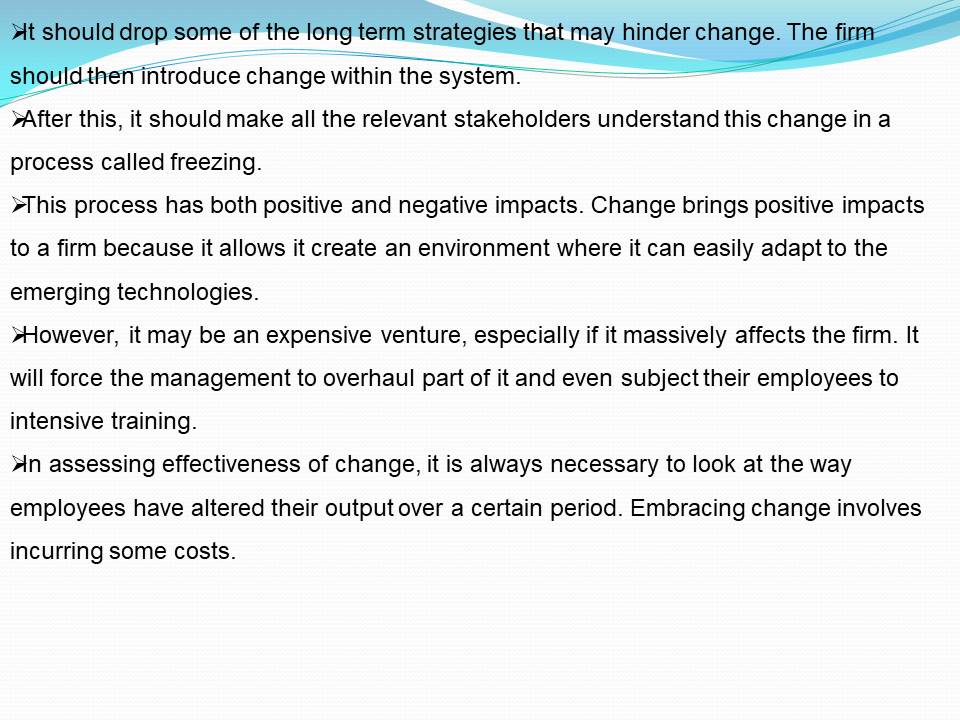
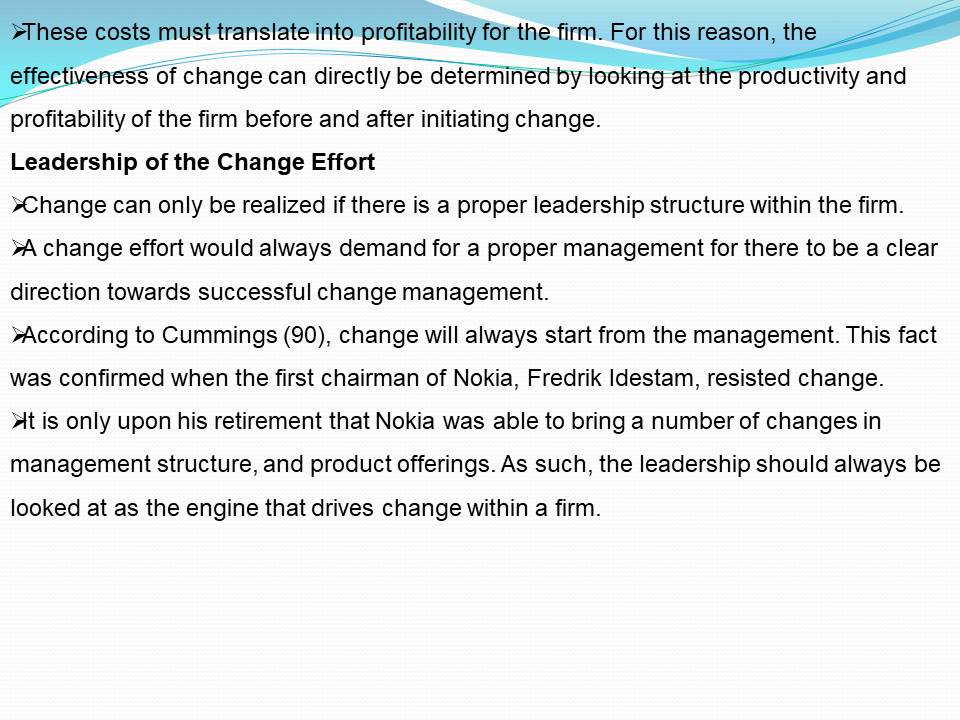
Summary
Using a balance scorecard, it is clear that Nokia has been successful in its recent operations in the market. Analysis done using financial and nonfinancial measures clearly indicates that this firm has been successful in the market over the recent years.
The balance scorecard approach points out to the major financial and nonfinancial strides this firm has made in the market. It is clear from the above discussion that change is very important for firms in the current business environment. The business environment has become so competitive that only those firms that are dynamic can survive.
Nokia has realized the importance of dynamism, and its leadership has been keen to embrace it. This firm has developed an organizational culture and leadership structure that allow employees to exploit their potential and express their innovativeness within the firm.
It is this flexibility and sensitivity towards change that scholars have recommended for firms that wish to remain competitive in the market.
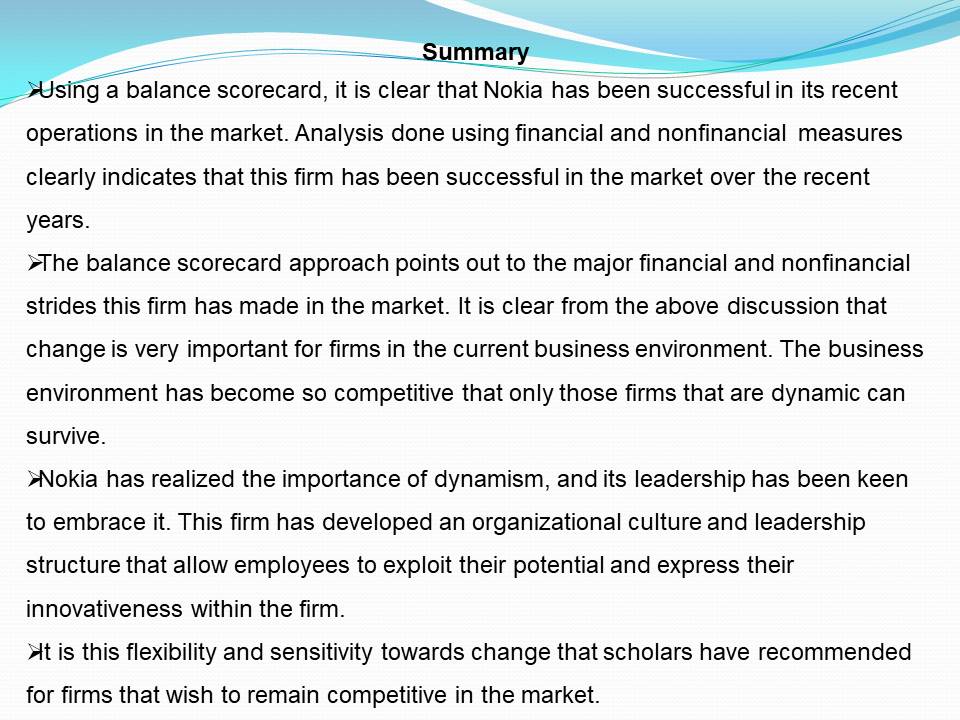
Works Cited
Adams, John. Organization Development and Change. Washington: National Training and Development Service, 1974. Print.
Anderson, Donald. Cases and Exercises in Organization Development & Change. Los Angeles: Sage, 2012. Print.
Bradford, David. Reinventing Organization Development: New Approaches to Change in Organizations. Hoboken: John Wiley & Sons, 2005. Print.
Cummings, Thomas. Organization Development & Change. Australia: Cengage Learning, 2009. Print.